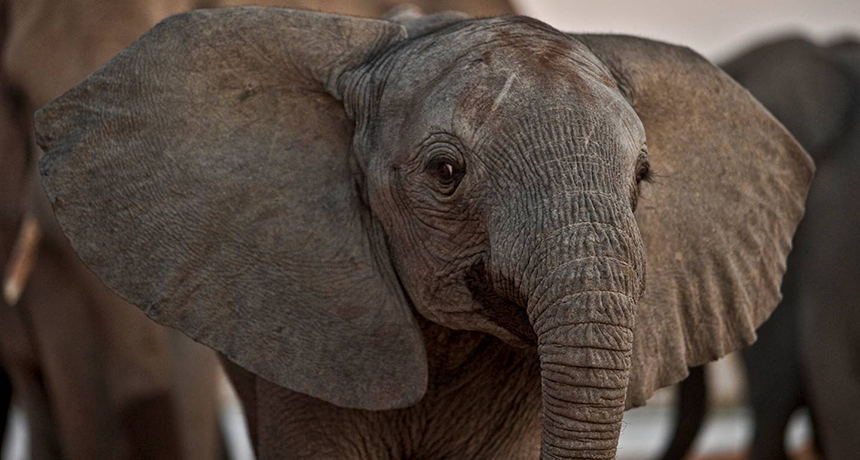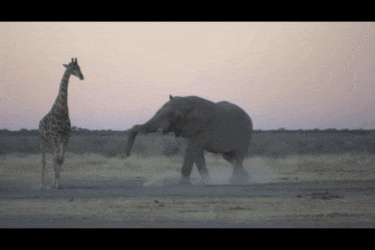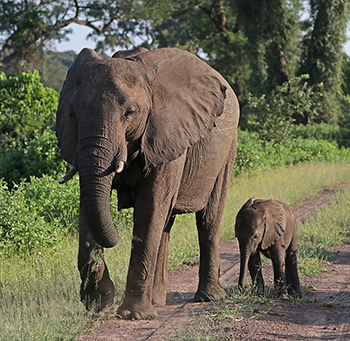Could an elephant ever fly?
Sorry, but even young Dumbo’s still not small enough

Little elephants have big ears. But are they big enough to fly? Well … no.
O’Connell & Rodwell/The Elephant Scientist
Elephants can’t fly. Unless, of course, the elephant in question is Dumbo. In the cartoon and the new, computer-enhanced live version of the tale, a baby elephant is born with enormous ears — even for an elephant. Those ears help him fly and soar to stardom in the circus. But could an African elephant — even a small one like Dumbo — ever take to the skies? Well, science shows, the elephant would have to get smaller. A lot smaller.
Elephant ears are not just useless flaps, notes Caitlin O’Connell-Rodwell. At Stanford University in California, she studies how elephants communicate. First, of course, an elephant’s ear is for listening. “When they’re listening, they hold their ears out and scan,” O’Connell-Rodwell says. Fanning and curving their big ears makes a shape rather like a satellite dish. That helps the elephants pick up sounds over very long distances.

The ears can send signals too, O’Connell-Rodwell notes. “You’d think these giant floppy things are sitting there,” she says. “But [elephants] do have a lot of dexterity in their ears, and they use that as a communication aid.” Different ear motions and poses tell other elephants (and scientists) about an elephant’s mood.
Elephant ears take up a lot of real estate. That’s especially true for African elephants, which have ears much larger than their Asian elephant relatives. An African elephant’s ears are around 1.8 meters (6 feet) from top to bottom (that’s taller than the average height of an adult man). The huge, floppy appendages are full of blood vessels. This helps an elephant stay cool. “They fan their ears back and forth,” O’Connell-Rodwell explains. This “moves more blood in and out of the ears and dissipates the [body] heat.”
But can they fly?
An elephant’s ears are big. And they are muscled, so elephants can move them around. The animal can hold those ears out stiffly. But could those ears hold an elephant up? They’d have to be big. Very, very big.
Animals that fly — from birds to bats — use wings or flaps of skin as airfoils. When a bird moves through the air, air passing over the top of the wing moves more quickly than air passing underneath. “The difference in speed causes a pressure change that pushes the bird up,” explains Kevin McGowan. He’s an ornithologist — someone who studies birds — at the Cornell Lab of Ornithology in Ithaca, N.Y.
But wind speed can only provide so much lift. As a general rule, McGowan says, a bigger animal would need bigger wings. The wings would need to get longer and wider. But the animal’s body would also have a lot more volume. That means a big increase in mass. “If you increase a bird’s size one unit, the [wing area increases] by one unit squared,” he says. “But the mass goes up by one unit cubed.”

Wing size can’t increase fast enough to keep up with an increased body size. So birds can’t get very big. “It gets harder [to fly] the bigger you get,” McGowan explains. That, he notes, is why “you don’t see a lot of flying birds that weigh very much.” The heaviest bird currently taking to the skies, McGowan notes, is the great bustard. This slightly turkey-like bird hangs out on plains in central Asia. The males weigh up to 19 kilograms (44 pounds).
Being lighter helps, though. To keep their bodies as light as possible, birds evolved hollow bones. The shafts running down their feathers also are hollow. Birds even have fused bones, so they don’t need heavy muscle to hold their wings in position. As a result, a bald eagle can have a 1.8-meter wingspan but weigh a mere 4.5 to 6.8 kilograms (10 to 15 pounds).
An elephant is much, much bigger than even the biggest birds. A newborn baby elephant weighs in at 91 kilograms (around 200 pounds). If a bald eagle was that heavy, its wings would have to be 80 meters (262 feet) long. That’s most of the length of an American football field. And of course the eagle (or elephant) would then need the muscle to flap those huge, huge wings (or ears).
To launch an elephant
“Elephants have a lot of things going against [flight],” notes McGowan. The mammals are graviportal — which means their bodies are adapted to their great weight. And just like us, their ear flaps have only cartilage, not bone. Cartilage can’t hold a stiff shape in the same way that the bones in a wing can.
But O’Connell-Rodwell says not to lose hope. “My image of the original Dumbo is that he soared rather than flew,” she says. “He’d get up on a high part of the tent pole and soar.” Under the right conditions, evolution — the process that allows organisms to adapt over time — might get an elephant there. “Flying squirrels developed a flap of skin” that allowed them to glide, she notes. What’s to stop an elephant?
A flying elephant would need a small body and a wing-like structure. But smaller elephant-like creatures have existed in the past. Between 40,000 and 20,000 years ago, a group of big mammoths were stranded on the Channel Islands off the coast of California. Over time, they shrank. By the time that population died out more than 10,000 years ago, they were only half the size of normal mammoths.
That could happen again, O’Connell-Rodwell says. One could imagine an isolated population of elephants getting smaller over thousands of years. To have a chance at flight, the elephants would have to shrink down to the size of something like one of their closest relatives — the “giant” golden mole. This little mammal lives in South Africa. It’s only about 23 centimeters (9 inches) long — or one-twentieth the length of a normal elephant.
A tiny mole-elephant would need a big flap of skin, like a flying squirrel. Or perhaps big, rigid ears would suffice. Then, the new tiny creature would have to climb to the top of tree, spread its ears and jump.
Then it wouldn’t just fly. It would soar.







